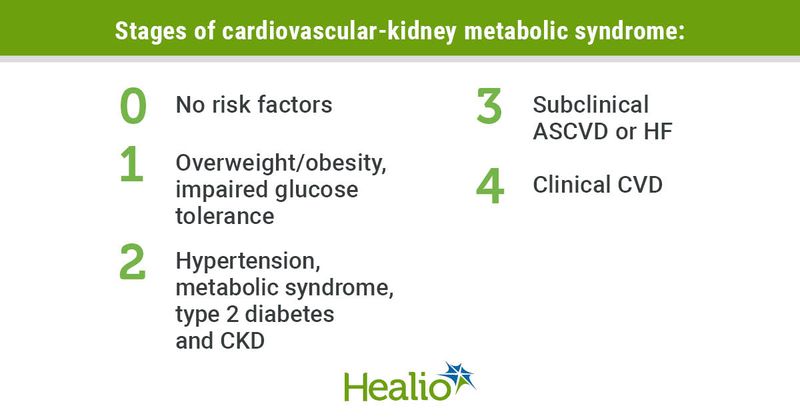Cardiovascular
AHA highlights disease overlap with new term: Cardiovascular-kidney-metabolic syndrome
October 09, 2023
3 min read
Source/Disclosures
Published by:
Disclosures:
The authors report no relevant financial disclosures.
Key takeaways:
- The term “cardiovascular-kidney-metabolic syndrome” highlights the confluence of metabolic and renal risk factors driving CVD.
- More research is needed on cardioprotective therapies with multisystem effects.
The American Heart Association unveiled a new term to reflect the interplay of several metabolic and renal conditions driving risk for CVD, along with an updated algorithm and guidance for screening, management and collaborative care.
The term, cardiovascular-kidney-metabolic (CKM) syndrome, was created to underscore the connection between obesity, type 2 diabetes, chronic kidney disease (CKD) and the CV system, according to the AHA. The term also reflects the development of new therapies that improve glycemic control and prevent both worsening kidney disease and CVD. A presidential advisory and accompanying scientific statement explaining CKM were published in Circulation.
“It is important to define CKM syndrome because it results in multiorgan dysfunction and in premature morbidity and mortality, primarily due to a higher burden of CVD,” Chiadi Ndumele, MD, PhD, FAHA, associate professor of medicine and director of obesity and cardiometabolic research at Johns Hopkins University, told Healio. “CKM syndrome is disproportionately prevalent in those with adverse social determinants of health, and it is therefore a major contributor to CVD disparities in the population. CKM syndrome includes those at risk for CVD and those with existing CVD, where the presence of CKM risk factors like obesity, diabetes and chronic kidney disease lead to unique considerations for care.”
In the presidential advisory, Ndumele and colleagues noted that there is major clinical and public health urgency associated with CKM syndrome; however, there is also considerable potential for improving CKM health, citing a growing array of therapeutic options that favorably impact metabolic risk factors, risk for adverse kidney events, or both, which also protect against CVD.

Chiadi Ndumele
“Defining CKM syndrome will help health care professionals to identify these individuals and to provide timely and appropriate care,” Ndumele, also chair-elect for the AHA Council on Lifestyle and Cardiometabolic Health, said during an interview.
New tools to assess risk
Researchers provided two tools to help assess risk for the condition. The first is a CKM staging construct — stages 0 through 4 — that can be used in both children and adults that reflects the progressive pathophysiology of CKM syndrome. Stage 0 applies to people attaining and maintaining ideal CV health; stage 1 applies to people with overweight or obesity who could benefit from lifestyle interventions, weight loss or bariatric surgery; stage 2 applies to people with metabolic and renal risk factors including hypertension, metabolic syndrome, type 2 diabetes or CKD; stage 3 applies to people with subclinical atherosclerotic CVD or subclinical HF; and stage 4 is the highest risk category reserved for those with CVD or kidney failure.
Researchers also provided algorithms for CV prevention and management, with specific recommendations tied to different CKM stages, as well as an updated approach to CVD risk prediction that includes factors such as early menopause and adverse pregnancy outcomes and incorporates social determinants of health, reflecting the needs of people with CKM syndrome.
“We describe the need to consider HF as an outcome in addition to ASCVD, to consider risk prediction starting at earlier ages, and to consider additional predictors relevant to CKM syndrome, particularly measures of kidney function and social determinants of health,” Ndumele told Healio. “The prediction model is incorporated within the CKM staging construct, with high predicted CVD risk as a criteria for stage 3 CKM.”
More details about the new risk prediction model will be unveiled at the upcoming AHA Scientific Sessions, Ndumele said.
Earlier identification, enhancing prevention
Ndumele said this approach will lead to the earlier identification of metabolic risk factors and CKD, which will enhance prevention for both adults and youths.
“We emphasize healthy lifestyle and support to facilitate ideal CV health for all individuals,” Ndumele said. “For those in higher CKM stages, we describe intensified approaches to screening and preventive therapies, because of their higher absolute CVD risk. Considering social determinants of health and interdisciplinary care approaches in the care model for CKM syndrome will facilitate more holistic therapeutic approaches. We also emphasize CKM regression, where individuals can regress from later to earlier CKM stages with marked lifestyle changes and weight loss, as an important clinical and public health message. Optimizing CKM health in the population would have a profound positive impact on trends for CV morbidity and mortality.”
Ndumele noted that CKM syndrome is often associated with fragmented care, due to multiple organ systems being affected. “Therefore, our multidisciplinary group worked to harmonize approaches across major guidelines from different specialties, and we also describe strategies to promote interdisciplinary approaches to care,” Ndumele said.
For more information:
Chiadi Ndumele, MD, PhD, FAHA, can be reached at [email protected]; X (Twitter): @chiadindumele.

